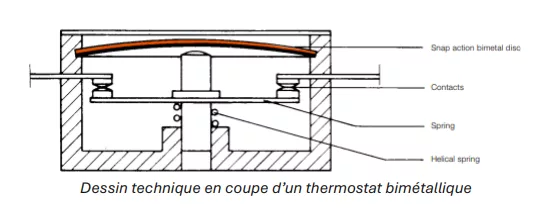
In the field of temperature sensors, hysteresis is the difference in behavior of a system as a function of temperature variation. It plays a crucial role, particularly in the operation of bimetal thermostats, Heito’s flagship products. Understanding hysteresis helps optimize the performance and reliability of temperature control systems.
What is hysteresis ?
Imagine a thermostat that needs to maintain a constant temperature. Ideally, it should switch on and off instantly when the temperature reaches the set threshold. However, due to hysteresis, the thermostat doesn’t reset immediately. There is a time lag between the rising trigger temperature and the falling reset temperature.
This offset is called the “hysteresis band”. It is intentionally introduced into control systems to avoid rapid oscillations and frequent switching, which can damage components, reduce system life and lead to power supply overloads.
Hysteresis in bimetal thermostats
Bimetallic thermostats, such as those designed by Heito, use hysteresis to ensure stable, reliable temperature control. The principle is simple: two different metals, with different coefficients of thermal expansion, are laminated together. When the temperature changes, the metals expand or contract at different rates, causing the bimetal to deform.
This deformation actuates an electrical contact, which activates or deactivates the heating or cooling system. Hysteresis is achieved by adjusting the shape of the bimetal, giving it a snap-action behavior.
Advantages of hysteresis in temperature control
- System stability: Hysteresis avoids rapid switching cycles, ensuring a more stable temperature and longer equipment life.
- Reduced wear: By limiting the number of switching operations, hysteresis reduces wear on electrical contacts and other components.
- Energy savings: More stable thermal regulation prevents overheating and overcooling, resulting in energy savings.
- Greater reliability: Hysteresis makes thermal control systems more robust and less sensitive to external disturbances.
Applications de l’hystérésis chez Heito
The know-how lies in the specific shape of the bimetal. This determines not only the switch-on and switch-off temperatures, but also the difference between the two, which we can adjust from 3° to 260°, depending on your needs.
When you choose Heito bimetallic thermostats, you benefit from the expertise of a leader in the field of temperature control. Our products are designed to offer exceptional performance, reliability and durability, enabling you to optimize the operation of your equipment and guarantee the safety of your applications.
Please contact us to discuss your specific requirements and find out how our thermal control solutions can help you achieve your goals.
 FRANçAIS
FRANçAIS